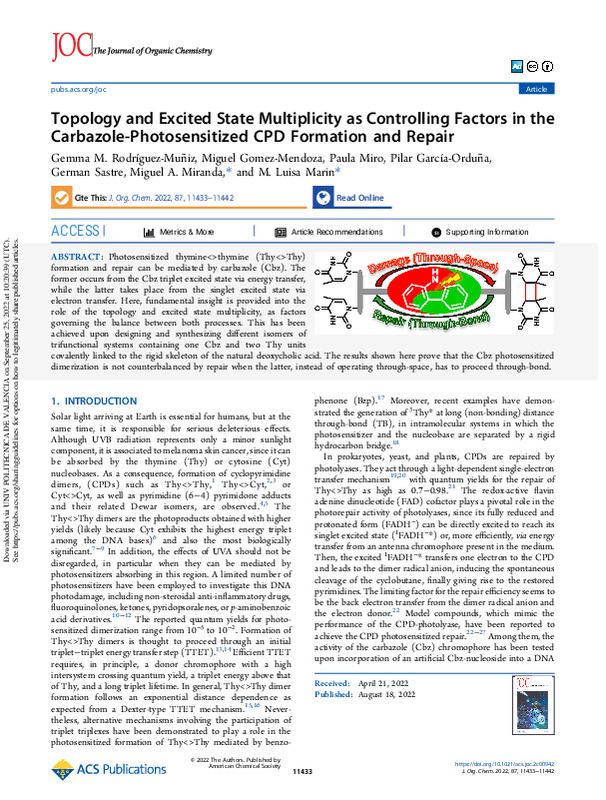JavaScript is disabled for your browser. Some features of this site may not work without it.
Buscar en RiuNet
Listar
Mi cuenta
Estadísticas
Ayuda RiuNet
Admin. UPV
Topology and Excited State Multiplicity as Controlling Factors in the Carbazole-Photosensitized CPD Formation and Repair
Mostrar el registro sencillo del ítem
Ficheros en el ítem
| dc.contributor.author | Rodríguez Muñiz, Gemma María
|
es_ES |
| dc.contributor.author | Gómez-Mendoza, Miguel
|
es_ES |
| dc.contributor.author | Miró, Paula
|
es_ES |
| dc.contributor.author | García-Orduña, Pilar
|
es_ES |
| dc.contributor.author | SASTRE NAVARRO, GERMAN IGNACIO
|
es_ES |
| dc.contributor.author | Miranda Alonso, Miguel Ángel
|
es_ES |
| dc.contributor.author | Marín García, Mª Luisa
|
es_ES |
| dc.date.accessioned | 2023-07-10T18:03:07Z | |
| dc.date.available | 2023-07-10T18:03:07Z | |
| dc.date.issued | 2022-09-02 | es_ES |
| dc.identifier.issn | 0022-3263 | es_ES |
| dc.identifier.uri | http://hdl.handle.net/10251/194795 | |
| dc.description.abstract | [EN] Photosensitized thymine<>thymine (Thy<>Thy) formation and repair can be mediated by carbazole (Cbz). The former occurs from the Cbz triplet excited state via energy transfer, while the latter takes place from the singlet excited state via electron transfer. Here, fundamental insight is provided into the role of the topology and excited state multiplicity, as factors governing the balance between both processes. This has been achieved upon designing and synthesizing different isomers of trifunctional systems containing one Cbz and two Thy units covalently linked to the rigid skeleton of the natural deoxycholic acid. The results shown here prove that the Cbz photosensitized dimerization is not counterbalanced by repair when the latter, instead of operating through-space, has to proceed through-bond. | es_ES |
| dc.description.sponsorship | Financial support from the Spanish Government (grant SEV- 2016-0683) , Generalitat Valenciana (PROMETEO/2017/075 and PROMETEO/2021/077) , and Technical University of Valencia (Predoctoral FPI fellowship for P.M.) is gratefully acknowledged. G.S. thanks CTI-CSIC for the use of computa- tional facilities. | es_ES |
| dc.language | Inglés | es_ES |
| dc.publisher | American Chemical Society | es_ES |
| dc.relation.ispartof | Journal of Organic Chemistry | es_ES |
| dc.rights | Reconocimiento (by) | es_ES |
| dc.subject.classification | QUIMICA ORGANICA | es_ES |
| dc.title | Topology and Excited State Multiplicity as Controlling Factors in the Carbazole-Photosensitized CPD Formation and Repair | es_ES |
| dc.type | Artículo | es_ES |
| dc.identifier.doi | 10.1021/acs.joc.2c00942 | es_ES |
| dc.relation.projectID | info:eu-repo/grantAgreement/GENERALITAT VALENCIANA//PROMETEO%2F2017%2F075//REACCIONES FOTOQUIMICAS DE BIOMOLECULAS./ | es_ES |
| dc.relation.projectID | info:eu-repo/grantAgreement/GVA//PROMETEO%2F2021%2F077/ | es_ES |
| dc.relation.projectID | info:eu-repo/grantAgreement/MINECO//SEV-2016-0683/ | es_ES |
| dc.rights.accessRights | Abierto | es_ES |
| dc.contributor.affiliation | Universitat Politècnica de València. Escuela Técnica Superior de Ingenieros Industriales - Escola Tècnica Superior d'Enginyers Industrials | es_ES |
| dc.description.bibliographicCitation | Rodríguez Muñiz, GM.; Gómez-Mendoza, M.; Miró, P.; García-Orduña, P.; Sastre Navarro, GI.; Miranda Alonso, MÁ.; Marín García, ML. (2022). Topology and Excited State Multiplicity as Controlling Factors in the Carbazole-Photosensitized CPD Formation and Repair. Journal of Organic Chemistry. 87(17):11433-11442. https://doi.org/10.1021/acs.joc.2c00942 | es_ES |
| dc.description.accrualMethod | S | es_ES |
| dc.relation.publisherversion | https://doi.org/10.1021/acs.joc.2c00942 | es_ES |
| dc.description.upvformatpinicio | 11433 | es_ES |
| dc.description.upvformatpfin | 11442 | es_ES |
| dc.type.version | info:eu-repo/semantics/publishedVersion | es_ES |
| dc.description.volume | 87 | es_ES |
| dc.description.issue | 17 | es_ES |
| dc.identifier.pmid | 35980822 | es_ES |
| dc.identifier.pmcid | PMC9447287 | es_ES |
| dc.relation.pasarela | S\471512 | es_ES |
| dc.contributor.funder | GENERALITAT VALENCIANA | es_ES |
| dc.contributor.funder | Ministerio de Economía, Industria y Competitividad | es_ES |
| dc.contributor.funder | Universitat Politècnica de València | es_ES |








